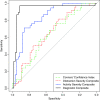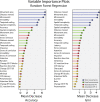Hyperactivity persists in male and female adults with ADHD and remains a highly discriminative feature of the disorder: a case-control study
- PMID: 23134619
- PMCID: PMC3560176
- DOI: 10.1186/1471-244X-12-190
Hyperactivity persists in male and female adults with ADHD and remains a highly discriminative feature of the disorder: a case-control study
Abstract
Background: Symptoms of hyperactivity are believed to fade with age leaving ADHD adults mostly inattentive and impulsive. Our aim was to test this assertion using objective measures of hyperactivity, impulsivity and inattention.
Method: Participants were 40 subjects with ADHD (23M/17F; 35±10 yrs) and 60 healthy adults (28M/32F; 29±9 yrs) blindly assessed using Wender-Reimherr interview ratings, Structured Clinical Interview for DSM-IV Disorders and DSM-IV criteria. Infrared motion capture systems tracked head and leg movements during performance of a No-4's cognitive control task. Subjects also completed the Conners' CPT-II.
Results: ADHD and controls differed significantly in activity and attention. Effect sizes for activity measures (d' = 0.7-1.6) were, on average, two-fold larger than differences in attention or impulsivity, correlated more strongly with executive function ratings and were more discriminatory (ROC area = 0.83 for activity composite, 0.65 for No-4's distraction composite, 0.63 for Conners' CPT-II confidence index, 0.96 for the combined activity and attention diagnostic index). This finding was true for subjects with the predominantly inattentive subtype as well as subjects with combined or predominantly hyperactive/impulsive subtype. Males and females with ADHD were equally active. The superior accuracy of activity measures was confirmed using Random Forest and predictive modeling techniques.
Conclusions: Objectively measured hyperactivity persists in adults with ADHD and is a more discriminative feature of the disorder than computerized measures of inattention or impulsivity. This finding supports the hypothesis that a deficient ability to sit still remains a defining feature of the disorder in adults when it is measured objectively.
Figures



Similar articles
-
Diagnosis of ADHD in adults: what is the appropriate DSM-5 symptom threshold for hyperactivity-impulsivity?J Atten Disord. 2012 Nov;16(8):631-4. doi: 10.1177/1087054711416910. Epub 2011 Oct 5. J Atten Disord. 2012. PMID: 21976031
-
Psychometric properties of the Wender-Reimherr Adult Attention Deficit Disorder Scale.Psychol Assess. 2013 Sep;25(3):942-50. doi: 10.1037/a0032797. Epub 2013 May 6. Psychol Assess. 2013. PMID: 23647041
-
Clinical symptoms and performance on the Continuous Performance Test in children with attention deficit hyperactivity disorder between subtypes: a natural follow-up study for 6 months.BMC Psychiatry. 2011 Apr 19;11:65. doi: 10.1186/1471-244X-11-65. BMC Psychiatry. 2011. PMID: 21504587 Free PMC article. Clinical Trial.
-
Psychopathological rating scales for diagnostic use in adults with attention-deficit/hyperactivity disorder (ADHD).Eur Arch Psychiatry Clin Neurosci. 2006 Sep;256 Suppl 1:i3-11. doi: 10.1007/s00406-006-1001-7. Eur Arch Psychiatry Clin Neurosci. 2006. PMID: 16977549 Review.
-
A systematic review and meta-analysis comparing the severity of core symptoms of attention-deficit hyperactivity disorder in females and males.Psychol Med. 2024 Nov 4;54(14):1-22. doi: 10.1017/S0033291724001600. Online ahead of print. Psychol Med. 2024. PMID: 39494848 Free PMC article. Review.
Cited by
-
A trial-by-trial analysis reveals more intense physical activity is associated with better cognitive control performance in attention-deficit/hyperactivity disorder.Child Neuropsychol. 2016;22(5):618-26. doi: 10.1080/09297049.2015.1044511. Epub 2015 Jun 10. Child Neuropsychol. 2016. PMID: 26059476 Free PMC article.
-
Objective Measures of Behavior Manifestations in Adult ADHD and Differentiation from Participants with Bipolar II Disorder, Borderline Personality Disorder, Participants with Disconfirmed ADHD as Well as Normative Participants.Clin Pract Epidemiol Ment Health. 2012;8:134-43. doi: 10.2174/1745017901208010134. Epub 2012 Nov 2. Clin Pract Epidemiol Ment Health. 2012. PMID: 23166565 Free PMC article.
-
Locomotor activity measures in the diagnosis of attention deficit hyperactivity disorder: Meta-analyses and new findings.J Neurosci Methods. 2015 Aug 30;252:14-26. doi: 10.1016/j.jneumeth.2015.03.001. Epub 2015 Mar 11. J Neurosci Methods. 2015. PMID: 25770940 Free PMC article.
-
Girls With Social and/or Attention Deficit Re-Examined in Young Adulthood: Prospective Study of Diagnostic Stability, Daily Life Functioning and Social Situation.J Atten Disord. 2023 Jun;27(8):830-846. doi: 10.1177/10870547231158751. Epub 2023 Mar 13. J Atten Disord. 2023. PMID: 36915033 Free PMC article.
-
Data-driven profiles of attention-deficit/hyperactivity disorder using objective and ecological measures of attention, distractibility, and hyperactivity.Eur Child Adolesc Psychiatry. 2024 May;33(5):1451-1463. doi: 10.1007/s00787-023-02250-4. Epub 2023 Jun 30. Eur Child Adolesc Psychiatry. 2024. PMID: 37386204 Free PMC article.
References
-
- APA APA. Diagnostic and Statistical Manual for Mental Disorders, Fourth Edition (DSM-IV) Washington, DC: American Psychiatric Association; 1994.
-
- Wender PH. Attention-Deficit Hyperactivity Disorder in Adults. New York: Oxfrod University Press; 1995.
Publication types
MeSH terms
Grants and funding
LinkOut - more resources
Full Text Sources
Medical

